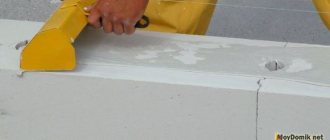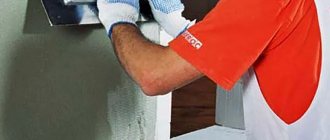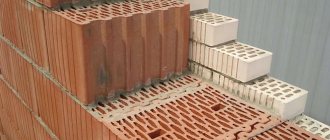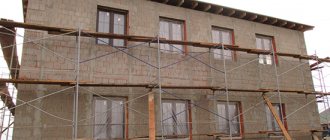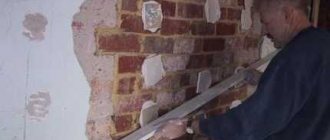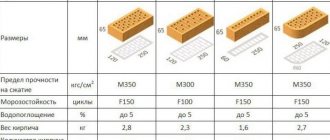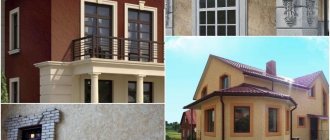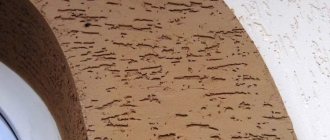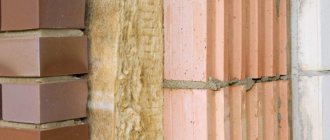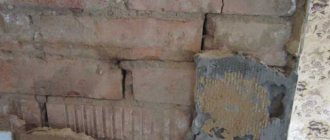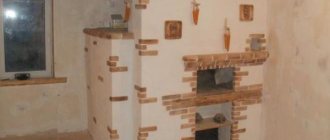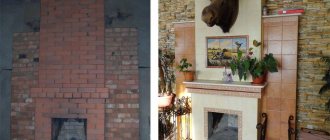Plastering walls made of aerated concrete and gas silicate is performed using the same methods, although these materials are different.
For the production of aerated concrete blocks, a concrete cellular mixture with round cells of 1 - 3 mm is used. diameter Shaped in the form of bricks. Curing can be natural or in an autoclave. Has low thermal conductivity.
Gas silicate blocks are also cellular blocks made on the basis of lime, sand, water and gas-forming additives (aluminum powder and analogues). Drying is carried out in special ovens. The products are characterized by slight sound insulation.
When to plaster aerated concrete walls indoors
Now let’s study the question of how to plaster aerated concrete walls inside various rooms, based on the time of year, temperature, and humidity.
Indoor work involves the release of large amounts of evaporated moisture. She needs to go outside. This happens most quickly if the outside walls are “bare”.
Sometimes it is necessary to maintain high permeability of walls in certain rooms. In these cases, you should use textile, non-woven or paper wallpaper for finishing. Vinyl is not recommended. They don't let steam through.
Types of plasters for aerated concrete blocks
Rice.
1. Types of plaster for aerated concrete and aerated silicate We choose what to plaster aerated concrete with to ensure the required properties - protection from temperature changes, weather resistance, excellent adhesion:
- Gypsum plaster for aerated concrete with perlite sand. Compatible with all finishing materials. It dries quickly, does not shrink, and allows you to make the surface as smooth as possible. No finishing coat required. Cons: high water consumption. A bag takes up to 15 liters. It should not be used outside as it does not withstand precipitation well.
- Cement is heavier and will not work without lime components. Therefore, a combined composition of cement, lime and additives is used.
- Silicate is made on the basis of potassium liquid glass. It is durable, moisture resistant, and easy to apply. Provides resistance to abrasion and dirt. The service life can reach 25 years.
- Silicone based on organosilicon polymers, resins. Provides strength and elasticity, protecting against cracking even during shrinkage. A good solution for facades. The downside is the higher price compared to other types.
The most popular manufacturers are Ceresit (mixtures CT 24 and 77), Osnovit (Startwell T-21), Baumit, Weber.pas. These products are certified according to modern standards and are of high quality and reliability.
We described in detail about other types of plaster here.
Table of technical characteristics of plaster mixtures for aerated concrete
| Characteristic | Index |
| Grit size, mm | 1 |
| Compressive strength (28 days), N/mm2 | ≥ 3,5 |
| Tensile strength in bending, N/mm2 | ≥ 0,5 |
| Thermal conductivity coefficient λ, W/mK | 0,8 |
| Vapor permeation resistance coefficient μ, | 15 |
| Density of dry composition, kg/m3 | 1600 |
| Water consumption, l/pack | 6 — 7 |
| Consumption of plaster mixture (when applied in a layer of 10 mm), kg/m2 | 15 |
| Min. Thickness of plaster layer, mm | 5 |
| Max. Thickness of plaster layer, mm | 20 |
Only after determining these indicators can you look at the cost if we are talking about materials with similar technical characteristics.
Features of plastering walls made of aerated blocks
It's better to start with the internal rough work. When the moisture comes out, move on to the outer walls and facade. But how to properly plaster a gas block in different rooms? If work is carried out in a damp room, a cement-based composition is used. It is not destroyed by water, but only gains strength. It is important to install a powerful hood. Plaster will last less. And over time it will collapse.
For work in bathrooms, mixtures of lime, cement and sand are used. You can use those you make yourself. Don't forget about reinforcement. A mesh with a density of at least 120 is used.
Gypsum plaster for a wall made of aerated concrete is suitable for residential premises. It is vapor permeable, which is important for creating the desired microclimate. Low material consumption is also ensured. The surface is easily smoothed to a glossy finish. Therefore, you don't have to putty it.
The final work is carried out with a special finishing solution. If the surface is plastered for wallpapering, it is not necessary to sand it. Smoothness is not required here. And when plastering for paint, you will have to eliminate minor defects. After all, they will be noticeable even after painting in several layers. The finishing layer is fine-grained putty. It is rubbed with sandpaper, and then dust is removed from the surface.
Thickness of plaster on aerated concrete
What is the best way to plaster aerated concrete for facade work, and how thick should the layer be? Vapor-permeable compounds are usually used:
- On a mineral and silicate basis - 2 mm or more.
- Lime-cement mixtures - from 10 mm.
- Silicone – 2 mm.
Rice.
2. Scheme of plastering a façade made of aerated concrete. If internal plastering of aerated concrete is carried out, the thickness depends on the composition. Typically gypsum mixtures are used. In this case, 2 to 5 mm of the mixture should be applied to the wall surface. Aerated concrete walls usually do not have significant differences or irregularities. Therefore, no leveling is required when performing interior work.
If you use cement plaster mixtures, the thickness should be at least 10 mm, otherwise they will crack and peel. If internal aerated concrete plaster is applied in rooms with high humidity levels, the requirements are as follows:
- Cement-sand-lime, self-mixing compositions – 15-20 mm.
- Ready-made cement-sand with additives and cement-lime - at least 10 mm.
Compliance with these requirements ensures reliability and durability.
If the thickness is 10 mm or more, beacons are used.
Required Tools
To complete the work, you will need a notched spatula with teeth up to 6 mm long, plastic or fiberglass mesh. Also prepare a deep penetration primer. If subsequent tiling is planned, a suitable adhesive is needed. To knead, you will need a construction mixer or drill with a suitable attachment. Also prepare a set of alignment beacons.
Work order
Applying plaster to aerated concrete blocks is carried out according to the following scheme:
- Preparing walls for plastering. If there are any unevenness or chips on them, they should be repaired. It is important to align everything to the same level. Any repair solution or special glue for this material will do. Consider structure. For example, a sawn block does not require additional preparation; formed ones need to increase their adhesive ability by opening the pores.
- Next, dust is removed with a metal brush.
- Now a layer of primer for aerated concrete is applied under the plaster. Use a roller, brush or spray to save money. They also often use an old vacuum cleaner, setting it to blow mode.
- It is important to use reinforcing mesh when plastering aerated concrete. It is secured with a small amount of mixture or construction fasteners.
- The first stage of plastering is carried out. The solution is applied mechanically or manually.
- The plaster is leveled according to the rule. Grouting is in progress.
- After complete removal of moisture, you can carry out a fine finishing or apply a decorative third layer of plaster.
Rice. 3. Applying a primer to aerated concrete and leveling the plaster
Cement composition
It can rightfully be called a favorite of the construction market, which has received recognition from experienced professionals in various types of finishing work, but it is impossible to plaster non-aerated concrete blocks with the help of non-aerated concrete blocks! And there are three unconditional reasons for this.
- The vapor permeability of cement mortar is significantly less than that of a gas block, as a result of which the microclimate of the interior is disturbed. This is manifested by an unpleasant smell of mold, the formation of black fungus on the walls and ceiling, and health problems for the residents of the house.
- Mixing the cement mortar requires the use of water, which will subsequently be absorbed by the masonry. As a result, the quality of the solution decreases, which leads to its inevitable peeling of the finish. And even a certified primer cannot help here.
- Low adhesion of the cement mixture will not guarantee reliable adhesion to the surface of aerated concrete blocks. This type of finish will need urgent repairs in just a couple of years.
How can you save money? To reduce the cost of plastering work, some craftsmen mix cement-sand mortar with specialized plaster for cellular blocks in a 1:1 ratio and add lime to the composition to increase adhesive properties. This option does exist, but no one can guarantee you the impeccable quality of plastering.
Subtleties of applying external plaster to aerated concrete
The procedure for applying plaster to aerated concrete for exterior work looks approximately the same. First, leveling is carried out, then priming with mixtures based on acrylate siloxane. After this, you will need a thin layer of mortar onto which the mesh is attached. It will protect against cracks.
After leveling, apply the next layer to form a smooth, uniform surface. Next is grouting and applying the finishing layer. After about a year, it is recommended to apply protection - a water repellent solution. It will provide a water-repellent effect.
Most often, construction begins in the spring and continues in the summer. The drying time of the foundation and walls is taken into account. First, the performers complete the external work, and move on to interior decoration as the weather gets colder. The required temperature is maintained by heating.
Ten years of experience of our specialists shows that the facade needs to be plastered only after the interior finishing and floor screed have completely dried. Otherwise, concrete, which has a cellular structure, will not be able to remove moisture in time.
When cold weather sets in, the condensation will turn into ice, destroying the material from the inside. If the cold takes you by surprise, it is better to wait with exterior work, limiting yourself to a primer that penetrates deeply into the pores.
The question arises: what should be used to plaster aerated concrete on the outside of a house to ensure durability? We offer several available options:
- If you need an inexpensive, breathable option, use a mineral composition. Water-repellent mixtures withstand significant temperature changes well and are inexpensive.
- Silicate plaster materials protect the facade from mold. Even if the surface has changed color after precipitation, it will dry out and return to its natural state. Also, the surface does not attract dust. The only negative is that there is no choice of colors. It can be removed by painting.
- Silicone plaster for gas block is also suitable. It is durable and plastic. Sold in various color variations.
The block structure absorbs moisture very quickly. Therefore, the mixture must contain moisture-retaining components. If there is little liquid, cracks will appear, and when there is a lot of it, the drying process will be delayed.
How to plaster the outside of a house?
Facade finishing is carried out in two ways: by applying plaster in one thick layer or in thin layers of 10 mm in several passes. The second method has significantly more advantages, so let’s consider it.
- We are preparing the walls.
The base should be carefully leveled to minimize the thickness of the solution and reduce its consumption. - Apply primer.
For these purposes, we recommend using deep penetration soil. - Apply the 1st layer.
It is necessary to fix the reinforcing mesh. - We carry out reinforcement.
We embed the facade mesh in the plaster layer. - Apply repeated layers.
In this case, the second one will have a leveling function, and the third one will have a finishing function. - We make decor.
To do this, we paint the surface in the desired color or apply textured decorative plaster with or without color. - We apply special equipment.
Most often, a water-repellent solution is used to protect decorative finishes from atmospheric moisture.
Does the technology for performing the work depend on the finishing of the facade?
When choosing how to plaster aerated concrete inside a house, take into account the façade finishing and the presence of external insulation.
Water vapor is constantly generated in the house. It appears during washing, cooking, during cleaning, when residents take a bath. Part of the moisture is removed through ventilation and removed naturally. But in winter this process slows down. The vapor pressure inside becomes higher than outside.
Moisture penetrates the wall, trying to escape. Success will depend on the vapor permeability of the external walls. The maximum indicator will be for a block without finishing. But no one will leave a “bare” wall. Therefore, it is important to create a structure in which vapor permeability (μ) gradually increases from indoors to outdoors. A reliable solution is to install a ventilated façade.
When work needs to be done
Plastering an aerated concrete facade
The beginning of finishing work begins after the construction of the building frame. Experts insist that before carrying out external work, the aerated concrete must be plastered inside.
The interval between the internal and external finishing of the facade should consist of 3 - 4 months. Before plastering the aerated concrete inside, the exterior finishing of the facade is carried out only in conditions where it is at risk of intense regular moisture - for example, when the house is located on the shore of a reservoir.
Important! After building a house, you need to wait about 6 months for the moisture accumulated during the construction process to naturally evaporate from the aerated concrete blocks. The favorable period for façade work is from April to September.
When to plaster a building made of aerated concrete
The final part of construction. It is carried out when the work is completed and the walls are dry, so that after plastering there is no wet work inside the room.
To avoid peeling, work is carried out on dry blocks. That is, work is carried out only in the summer. Recommended air temperature is from plus five degrees, air humidity is no more than eighty percent. It is better not to skip the initial stage of priming.
Work should not be carried out on a hot sunny day. Since rapid drying of the plaster layer can lead to the formation of cracks.
At the end, here are some tips from experienced craftsmen that are useful for practical use:
- Before buying material, read reviews about a particular manufacturer. It’s better to take an imported one, but you can also find a good domestic brand;
- If it is hot and sunny for a long time, and the blocks are very dry, it is better to moisten them a little;
- There is no need to add water to the external plaster, it is ready;
- Read the requirements carefully, there are nuances regarding the terrain (high humidity, swampy soil, dusty roads);
- After building the house, you need to let the walls dry, one month will be enough;
- You cannot start finishing the internal and external walls at the same time; you must follow the sequence - first the internal ones, let them dry, then the external ones.
To avoid peeling, work is carried out on dry blocks.
A house made of gas silicate blocks will last for many years, will be warm and cozy, if the interior and exterior finishing is done correctly, following construction technologies. You can save not only on interior decoration, but also on heating and ventilation. Choose the right plaster. Approach renovations wisely.
Conclusion
By consistently plastering aerated concrete walls and using only vapor-permeable materials, you can ensure a reliable finish that will decorate the facade of the house for many years. And planned repair work will be reduced to periodic painting to restore the color of the paint and eliminate small cracks.
Sources
- https://remontstroimat.com/chem-shtukaturit-gazobeton-snaruzhi-doma-dlya-polnocennoj-zashhity-ot-neblagopriyatnyx-vozdejstvij/
- https://DekorShtukaturka.ru/oshtukaturivanie/shtukaturka-gazobetona
- https://fasad-exp.ru/vidy-materialov-dlya-otdelki-fasadov/shtukaturka/fasadnaya-shtukaturka-dlya-gazobetona.html
- https://kraski-net.ru/obrabotka-sten/oshtukaturivanie/po-gazobetonu-dlya-naruzhnyh-rabot
- https://beton-house.com/stroitelstvo/iz-gazobetona/otdelka/chem-shtukaturit-gazobeton-snaruzhi-124
- https://strir.ru/naruzhnaya-otdelka/shtukaturka-gazobetona
- https://moydomik.net/fasad/361-shtukaturka-sten-gazobetona-otdelka.html
[collapse]
Vapor permeability and humidity balance
If plastering of aerated concrete walls was carried out using heavy cement mixtures, it is important to ensure proper ventilation. The best solution would be forced exhaust systems. They allow you to remove excess moisture.
If the aerated concrete surface is protected from the outside by a ventilated façade system, a gap is provided to allow vapors from the room to freely escape outside. This allows you to use different types of plaster for aerated concrete without fear of disturbing the vapor permeability parameters. Do not use foam for protection. It has almost zero vapor permeability. Mineral wool will do.
If you want to balance the humidity, then when finishing the interior, use materials with a vapor permeability lower than that of the blocks. These can be special hydrophobic impregnations, paints, compositions with a dense consistency or moisture-resistant wallpaper. However, in this case, the importance of arranging high-quality ventilation increases. Otherwise, a greenhouse effect will occur.
Properties of gas silicate material and its protection using a plaster layer
Silicate blocks are a modern building material characterized by a cellular structure. They are made from a mixture of quartz sand and cement, to which aluminum powder and lime are added. When the ingredients are mixed, a chemical reaction occurs, as a result of which the gas silicate solution increases its volume and then hardens in special forms.
Gas silicate based blocks are used as building materials for the construction of buildings.
As a result of the gas formation reaction, the blocks acquire a porous structure, which determines the main performance characteristics of the material:
- reduced thermal conductivity. Gas silicate walls reduce thermal energy losses and reduce heating costs;
- ability to absorb noise. Cells unevenly distributed inside the blocks prevent extraneous noise from entering the room;
- increased vapor permeability. Air exchange occurs through the pores, improving the microclimate of the living space.
In addition, the blocks have energy-saving properties. They gradually accumulate thermal energy, which is then transferred to the room and increases its temperature.
Silicate blocks have positively proven themselves in the field of low-rise and industrial construction due to the following advantages:
- reduced weight;
- increased strength characteristics;
- increased volume;
- correct geometry;
- minimum tolerances on dimensions;
- good machinability;
- environmental cleanliness;
- frost resistance;
- fire safety.
In the field of low-rise construction, silicate blocks have proven themselves positively.
Gas silicate is also resistant to the formation of fungi and the development of mold. In terms of performance characteristics, gas silicate blocks are similar to foam concrete products. However, both materials have a number of serious disadvantages, to eliminate which gas silicate blocks are plastered, and foam blocks are also plastered.
The need to plaster the surface of porous blocks is associated with the following properties of the material:
- increased hygroscopicity. Porous gas silicate is prone to absorbing moisture, which causes gradual destruction of the material at negative temperatures, and also contributes to the development of microorganisms. To prevent cracking of the blocks, they are plastered;
- reduced adhesion of the cellular surface of the blocks to finishing materials. Plaster mixtures based on sand and cement, as well as lime-based plasters, do not adhere well to porous gas silicate. Carrying out finishing measures allows you to increase adhesion;
- moisture condensation inside the gas silicate mass. As a result of intensive air exchange occurring under conditions of temperature changes, moisture accumulates inside the blocks. It makes it difficult for air vapor to escape from the room and negatively affects the microclimate.
To ensure adhesion of the gas silicate surface, the following work is carried out:
- cover the gas silicate with a special solution. The soil penetrating deep into the cellular gas silicate improves adhesive properties;
- reinforce the gas silicate surface with metal, nylon or fiberglass mesh. It allows you to apply an increased layer of plaster;
- Several layers of plaster are applied successively. Layer-by-layer finishing allows you to create a smooth surface with increased adhesive properties.
The cellular structure determines the need to protect the surface of gas silicate blocks.
The need to protect the surface of gas silicate blocks and other products made of porous concrete is determined by their cellular structure. Finishing gas silicate walls is a must.
Purpose of plastering:
- prevention of destruction of gas silicate walls as a result of temperature fluctuations;
- protection of gas silicate blocks from intense moisture absorption and development of microorganisms;
- improving the appearance of various buildings whose walls are built from gas silicate blocks;
- reducing the volume of heat loss through the unprotected surface of gas silicate walls;
- ensuring comfortable indoor conditions by providing increased sound insulation;
- leveling the surface of the walls after laying the blocks, allowing you to create a flat base for finishing;
- protection of block walls from the formation of cracks, allowing to increase the service life of the building.
Aerated concrete is susceptible to the influence of natural factors - precipitation, ultraviolet rays and weathering. In addition, porous gas silicate is destroyed as a result of mechanical damage. Plastering walls made of gas silicate blocks provides reliable protection throughout the period of operation.
Reliable protection is provided by plastering walls made of gas silicate blocks
Insulation of aerated concrete walls
Rice.
4. Laying insulation (mineral wool) on aerated concrete or gas silicate As soon as the aerated concrete plaster is applied, the wall should be insulated. Should we rush? If protection from moisture was not provided during construction, you must first dry the structure for 2 to 5 months (depending on the climate), and only then proceed with insulation.
If you choose from the available materials, it is better to buy extruded polystyrene foam. It has zero thermal conductivity. For a better fit to the wall, notches are made on the surface.
Polystyrene foam is often used for outdoor work. However, it is important to correctly calculate where the dew point will be. Foam insulation reduces the natural vapor conductivity of the walls. As mentioned earlier, this means the cost of a powerful forced ventilation system.
Mineral wool is also used. It is non-flammable and environmentally friendly. The service life when using high-quality samples from Knauf, Termolife and other brands is up to 70 years. A fiberglass mesh is attached over the mineral wool and a layer of glue is applied.
Exterior finishing
The technology of external plastering is practically no different from the process of internal work described above.
The only difference is the thickness of the coating: if 1-2 layers are enough on the inner surface, then on the outside the thin-layer method involves applying 3 layers, and the thick-layer method - 5-6. The plaster used for exterior work is the same as for interior use.
Each layer of applied plaster is necessarily reinforced with a fiberglass mesh. Naturally, this leads to certain expenses. However, it is better to spend a small amount at the finishing stage than to pay again for repairs after just a few years.
The applied layer must be given time to dry completely, and only then proceed to the formation of the next one. Therefore, it is preferable to carry out work in the warm season: pauses in the production process will be shorter.
After the plaster has completely dried, the surface can be painted. It is recommended to use only special vapor-permeable paints, for example, PASTEL, ATLAS or ARKOL S.
Manual and mechanical plastering of aerated concrete walls
You can mix and apply the material by hand. You control the process, but you spend more time. A mechanized station is much more efficient. Firstly, you save time. Secondly, you ensure the quality of surface treatment. Thanks to this equipment, aerated concrete plaster is laid down in an even layer, neatly.
There is another nuance. The installation grinds and mixes dry ingredients with water more efficiently. This way you achieve homogeneity of the mixture, which means the required parameters over the entire surface. The consistency is controlled by hardware. The speed of work increases by 3–4 times.
Rice. 5. Mechanical plaster
Less costs for materials, since they are cheaper for machine-assisted plaster. Thanks to pressure supply, adhesion to the wall improves. There are several disadvantages - you need a three-phase network, drying up to 7 days, high noise level. This is not relevant if the walls in a new building are being plastered.
Advantages of gas silicate
First, let's briefly look at the performance characteristics of the building material. Aerated concrete has a number of obvious advantages that explain the popularity of its use. In addition to the already mentioned attractive cost, these include:
- Clearly consistent block size. This allows for laying in perfectly even rows, and not a thick layer of ordinary mortar is used to adhere the blocks, but a thin layer of a special adhesive composition. As a result, “cold bridges” that cause a lot of inconvenience in the future do not form in the masonry.
- Light weight. The intensity of the load on the foundation and, as a consequence, the likelihood of uneven shrinkage depends on the total mass of the structure. If you follow the technology for laying lightweight aerated concrete blocks and carry out the necessary procedures for reinforcing the structure, you can not be afraid of distortions in the house and the appearance of wall cracks.
- Heat and sound insulating properties. According to this indicator, gas silicate occupies a leading position among the main building materials. The porous structure creates excellent energy-saving characteristics and prevents the penetration of external noise.
- High vapor permeability. This property of the material ensures the maintenance of a constant microclimate in the interior. The house will not be damp when it rains, and you will not have to use humidifiers in the dry heat.
Recommendations and requirements for the technology of the wall finishing process
Plastering work begins only after all “wet” stages of repair and finishing activities have been completed, when the surfaces both indoors and outdoors are completely dry. The maximum permissible humidity of aerated concrete blocks is 27%. Plastering of the facade is carried out at air temperatures in the range from +5 to +30 °C, with a relative humidity of no more than 80%.
You cannot plaster in strong winds or in hot weather; this can cause the solution to dry out quickly, and, as a result, the finish becomes covered with a web of microcracks and peels off. Working with plaster on a wall in direct sunlight leads to exactly the same result.
Is it possible to level the floor with tile adhesive and how to do it correctly
Installation of floor screed is a mandatory stage of surface preparation.
A perfectly flat floor is the key to quick, correct, even laying of the flooring without changes. One option is to level the floor with tile adhesive. During the renovation, I couldn’t believe for a long time how this was possible, but I took a chance and tried it, so I’m sharing my experience.
- Is it possible to level the floor with tile adhesive?
- Leveling floors with tile adhesive: technology
- Tile adhesive instead of self-leveling floor
- How long does it take for tile adhesive screed to dry?
- Video on the topic
You should work according to the instructions. The thickness of the layer should not be thicker than 10 mm; too thick can crack. Finishing is carried out at temperatures from +5°C to +30°C, at normal or low humidity. The working life of the finished test is taken into account. Dilute the required amount of powder.
Preparing the base
Old paint, wallpaper, plaster, and dirt are removed from the walls. The strength of the base is checked with a trowel and metal fastening elements are removed. Large potholes and cracks are repaired. Then the surface is primed and a reinforcing fiberglass mesh is attached. For smooth surfaces, select a primer with sand that creates roughness. While the soil dries, prepare the glue.
Preparation of the solution
Add the amount of water indicated on the package to the dry mixture. Craftsmen often mix glue “by eye”. If there is a lot of cement in the mixture, you can add sand or other mineral filler: marble or granite chips of various fractions, small pebbles. The finished solution should be elastic and easy to work with.
Application and creation of decorative coating
To obtain a high-quality finish, the adhesive mixture is applied in small areas. The glue takes a long time to dry, so you can create any texture using a plastic trowel. Immediately apply a thick layer with a spatula, which does not require perfect leveling.
Video of creating a decorative covering from tile adhesive
The plot clearly presents the technological process. You can verify in practice that there is nothing complicated in decorating walls with an adhesive mixture. It is enough to follow the advice of the master.
What solution is needed for laying aerated concrete blocks?
For masonry
aerated concrete blocks use mortar mixtures based on mineral binders with organic or polymer fillers.
The material must be suitable for thin-seam masonry
, which is used for
aerated blocks
.
Interesting materials:
Is it possible to turn on the ionizer in front of people? Is it possible to turn on the air conditioner without a filter? Is it possible to turn on the heating when wallpapering? Is it possible to turn on a submersible pump without water? Can a surge protector be included in a surge protector? Is it possible to log into VKontakte invisible? Is it possible to screw self-tapping screws into drywall? Is it possible to screw a self-tapping screw into a wall? Can sparrows eat seeds? Can I plug an extension cord into an extension cord?
To rub or not to rub (close) the adhesive seam of an aerated concrete wall.
We invite you to study on my YouTube channel at the “construction school”
Attention to the customer, see promotions on discounts on the prices of our products here
WE do low-rise projects of any complexity from Itong aerated concrete blocks with foundation calculations based on IGI. Prices are reasonable.
You can order a landscape design project for your site from us.
To grout or not to grout the masonry joint of an aerated concrete wall?
The question of whether or not to rub over the adhesive joint with Ytong glue when laying Ytong aerated concrete blocks or bonolit aerated concrete blocks, foam blocks sounds quite often - and the answer to it is not clear whether to rub over or not to rub over the adhesive joint of masonry walls.
The answer depends on a number of factors that determine whether it is necessary to grout (close) the adhesive joint with Ytong glue or bonolit glue when laying aerated concrete blocks at the Mozhaisk Itong aerated concrete block plant or not, and moreover, grouting the adhesive joint with Itong glue (closing) is sometimes even harmful. In the presented photographs of the construction of cottages, two options are visible - the seams are rubbed into the wall with Itong glue and the seams are not rubbed with Ytong glue. In the first case, the masonry of the walls of a cottage near the city of Istra is carried out using Ytong glue with a thickness of 500 mm from two types of Ytong aerated concrete blocks with a thickness of 200 mm and + 300 mm. In the same way, you can lay the walls of cottages from Bonolit aerated block using Bonolit glue. In the second case, the laying of aerated concrete walls of a house near the city of Golitsino is carried out using Ytong aerated concrete blocks using Ytong adhesive with a thickness of 375 mm. In the same way, you can lay the walls of a house using Bonolit aerated concrete blocks using Bonolit glue. Let's try to understand these factors, in order to sort them out, we need to understand the role of Itong glue in the laying of an aerated concrete wall from an aerated concrete block and the role of plaster in a wall made of Itong aerated concrete blocks, bonolit aerated concrete blocks.
1- Itong glue, as well as bonolit glue, ensures gluing of individual aerated concrete blocks, foam blocks into a monolithic aerated concrete wall. The strength of the gluing seams of aerated concrete blocks using Ytong glue in an aerated concrete wall of a house made from aerated concrete blocks, foam blocks from the manufacturers of Ytong aerated concrete blocks, or Gras from aerated concrete should not be less than the tensile strength of the aerated concrete block itself. That is, Itong glue ensures the solidity of the wall made of Ytong aerated concrete blocks, and bonolit from aerated concrete, and you need to know that the strength of gluing blocks in the wall depends on the gluing area of the adhesive surfaces of Itong aerated concrete blocks, Ytong foam blocks, and Grasse aerated concrete blocks, bonolit aerated concrete blocks from aerated concrete , foam concrete. The larger the area of adhesive surfaces of Gras aerated concrete blocks from the Maloyaroslavl plant or the Mozhaisk plant of Ytong aerated concrete blocks using Itong glue, the stronger the wall. That is, if we consider the wall of the cottage from this position, the less waste space in the aerated concrete wall of the cottage, the better for the strength of the aerated concrete wall. And here it is important to understand how many percent of the surfaces of Ytong or bonolit aerated concrete blocks should be glued with itong glue or bonolit glue to ensure the solidity of the aerated concrete wall of a cottage made of aerated concrete blocks, which directly affects the strength of the aerated concrete wall of aerated concrete blocks and the structure as a whole.
2- Plastering in the aerated concrete wall of a house made of Gras aerated concrete blocks provides protection for the cottage wall from atmospheric influences and by covering empty unfilled seams with Itong glue in a wall made of Gras aerated concrete blocks from the Maloyaroslavl plant or the Mozhaisk Ytong aerated concrete block plant, increases the solidity of the house wall. Closes open areas of wall seams from communication with the external environment, thereby reducing heat loss through seams in the cottage wall that are not filled with Ytong glue. The adhesion strength (adhesion) of plaster to an aerated concrete wall made of Itong aerated concrete blocks, Bonolit aerated concrete blocks depends on the quality of the plaster itself, that is, its adhesive properties and on the area (surface) of adhesion of the plaster to the aerated concrete wall of a house made of Bonolit aerated concrete blocks, the larger the adhesion surface of the aerated concrete wall with plaster, the more firmly the plaster is held on the aerated concrete wall of the cottage, and from this point of view, the presence of masonry seams made from Ytong aerated concrete blocks that are not rubbed (not covered) with Itong glue, and Grasse from aerated concrete, has a positive role, the plaster is held more firmly on the aerated concrete wall. This is clearly visible on brick walls, when, to increase the adhesion surface of a brick wall made of ceramic bricks, ceramic bricks with an increased active surface in the form of relief or vertical protruding ribs are used, the goal here is one, by taking into account the relief surface of the ceramic brick, to increase the adhesion surface of the plaster mortar to the surface brick wall made of ceramic bricks.
Characteristics of plaster
There are such types of plaster bases as mineral, silicate, acrylic and silicone.
Mineral-based material belongs to the finishing resources of the democratic segment. In addition, mineral plaster is not difficult to make yourself. Ready-made solutions contain:
- white cement;
- lime;
- marble chips and other fillers;
- special additives that improve the functional and decorative qualities of the product.
The products are presented in a limited range of colors, but the problem is easily solved by painting the coating.
Mineral plaster has a high level of vapor permeability and water absorption, and is inert to UV radiation. Sensitivity to pollution and resistance to biological damage is average, and the elasticity index is low.
Silicate plaster on gas silicate blocks is more convenient to apply, although it has average elasticity parameters. The connecting link in the mixture is liquid glass. The vapor permeability of silicate finishing is high, and the level of water absorption is average, all this determines the demand for products for finishing cladding of aerated concrete blocks. The silicate composition is sold in finished form; the cost of the product is slightly more expensive than dry mineral analogues.
The basis of silicone plaster is silicon-organic polymers. This is perhaps the best mixture option for cladding aerated concrete, as it is highly elastic and does not crack when the base shrinks. Silicone material is also known for the following advantages:
- easy to apply;
- has high vapor permeability characteristics and a low level of water absorption;
- inertness to pollution and biological influences.
Silicone plaster is offered in a wide variety of textures and colors. Ready-to-use products are sold in the expensive segment, this is the only negative in the collection of finishing materials.
Acrylic plaster is relevant for aerated concrete surfaces only if there is enhanced waterproofing of the walls and high-quality ventilation of the room. The lining is based on acrylic resin; the material is highly elastic. At the same time, the level of vapor permeability of the composition is low, as are the moisture absorption rates.
